

Animation Screencaps - (formerly DisneyScreencaps.com) Bringing you the very best quality screencaps of all your favorite animated movies: Disney, Pixar, & so many more! Movie Screencaps.com - Movie caps galore! Screenmusings Movie Screencaps. Color Palettes From Famous Movies Show How Colors Set The Tone Of A Film. (1) Luke Valadie. What is the 180 Degree Rule: Breaking the Line with Purpose.
Film Bytes. F R A M E F I L T E R. F R A M E F I L T E R. The Cinematography of "The Incredibles" - Part 1. Whether its up shots or down shots, you'll often find these lines that run through the character's eyes, again unconsciously leading your eyes to where the director wants you to focus.
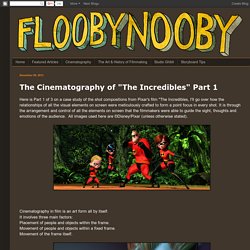
With so many nice angles that keep making the shots look visually interesting even when they are meant to be very simple, all reminds of the show Mad Men. Almost that retro look, I suppose The Incredibles is meant to be set in the 50s and then once they flash forward to after the marriage and the trial we're in the 60s. It's strong, graphic, bold cinematic storytelling displayed in the visual grammar of this film. Like in the Mad Men, The Incredibles has sleek color combinations and contrasting shapes, well balanced imagery, textures space on the screen is well balanced with flat texture-less areas, particular areas of each shot hold certain amounts of weight and value. See all the crazy angles in the following shots. The Cinematography of “Pulp Fiction” (1994) @ Evan E. Richards. DSLRguide. The Cinematography of "The Incredibles" Part 3. See Part 1 here, and Part 2 here.Continuing with my case study of the shot compositions from Pixar's film "The Incredibles".
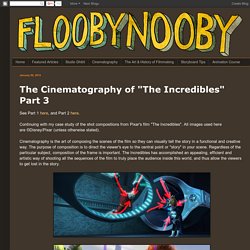
All images used here are ©Disney/Pixar (unless otherwise stated). Cinematography is the art of composing the scenes of the film so they can visually tell the story in a functional and creative way. The purpose of composition is to direct the viewer's eye to the central point or "story" in your scene. Jim Emerson’s Videos. Sylvain Riou. The Art of Cinematography - Page 1. Wolfcrow on Vimeo. Dan Fox. The Art of Cinematography - Page 1. Learning Visual Vocabulary: 4 Years of Film School in 100 videos. Adam Schnitzer on Vimeo. Kevin B. Lee’s Videos on Vimeo. Montivagus Productions’s Videos on Vimeo.
HorrorOldSchool. Spectacular Attractions. Jump Cuts: The Good, The Bad, of the Discontinuous Edit. Recently I asked the question to the Twitter-verse to get some insight from my fellow editors.
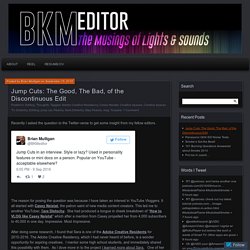
The reason for posing the question was because I have taken an interest in YouTube Vloggers. It all started with Casey Neistat, the patron saint of new media content creators. This led me to another YouTuber, Sara Dietschy. She had produced a tongue in cheek breakdown of “How to VLOG like Casey Neistat” which after a mention from Casey propelled her from 4,000 subscribers to 40,000 in one day. Impressive. After doing some research, I found that Sara is one of the Adobe Creative Residents for 2015-2016. In looking at Sara’s work on YouTube, I noticed a few things. Jump Cuts. Now, Vlogs are one thing. But I was seeing these jump cuts in other more traditional types of content, in this case, Sara Dietschy’s Creative Spaces TV. The main issue for me is that an interview with a person should be as conversational as possible.
And in reference to the examples: WATCH: With These Video Essays, Who Needs Film School? Cameron Carpenter's eye-opening video essay series asks the hard-hitting questions every filmmaker wants answered.
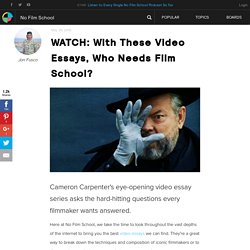
Here at No Film School, we take the time to look throughout the vast depths of the internet to bring you the best video essays we can find. They're a great way to break down the techniques and composition of iconic filmmakers or to discover themes that you can apply to your own work. Spielberg's Subtext - Mike Hill. Raccord’s Videos on Vimeo. The Royal Ocean Film Society on Vimeo. Filmmaking, Martin Scorsese and Cinematography. Cuts & Transitions 101. Cuts & Transitions 101. Top 50 YouTube and Vimeo Channels for Filmmakers and Cinephiles. There are numerous film-related YouTube and Vimeo channels that hold thousands of high quality material about filmmaking.
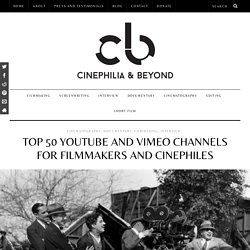
Whether you’re interested in directing, screenwriting, editing and cinematography, or interviews, behind-the-scene anecdotes, and making-of documentaries are really your thing, these are the channels and playlists we wholeheartedly recommend you to check out. Dear filmmakers, cinephiles, screenwriters, storytellers, movie buffs, film aficionados, or whatever you consider yourselves to be, take a look at this list of 50 great channels with countless hours of viewing pleasure. Every Frame a PaintingFilm School Thru CommentariesEyes On CinemaUK TV—Cinemania PAL|Soundtrack SpecialistCharles MLa cosa empezó asíLe Making Of Last but not least, there’s our own YT channel, where a whole bunch of film documentaries wait for you to dive in headfirst.
You can also find us on Vimeo. Get Cinephilia & Beyond in your inbox by signing in. Flooby Nooby: Cinematography. Something I try to make clear on a regular basis is that cinematography is only a part of the many pieces that make up a film.

Lighting, blocking and framing aside, colour and set design are obviously a big part of what we need to pay attention to, and here you can see a very specific pallet has been chosen for this film. From scene to scene there are different splashes here and there, but overall, shadows are warm and highlights cool - often, it's the other way around. Regardless, I absolutely love how colour was handled in this film. The pace of the first chapter is so perfect and the tension that Tarantino builds is almost traumatizing! To hit that sort of perfection you need amazing actors - Denis Menochet and Christoph Waltz bring so much to the story, far beyond, I believe, the genius words that Tarantino placed in front of them.
Film/Book Analysis. In this series of Favorite Films, we’ll feature the genre that drove many of us to do what we do: Animation.
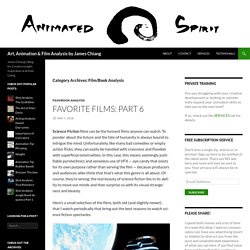
There are countless films that feature the use of animation, from live action to fully-animated cartoon features, including those that have lost their grasp in our fast-growing technological society, namely Hand-Drawn (2D) animation and Stop-Motion (sometimes referred to as claymation). Despite the host of good CG films that have been made in the past couple of decades I opted for this select group of traditionally crafted films because of their extraordinary quality and their impact on me personally.
You may feel differently. That said, I hope that you’ll revisit these films (assuming you’ve watched them all before) and see them as the incredible wonders that they are. Pinnochio (directed by Ham Luske & Ben Sharpsteen) According to Animation critic and historian, Charles Soloman, “Pinocchio remains the most perfect animated feature Walt Disney produced.” Top 50 YouTube and Vimeo Channels for Filmmakers and Cinephiles. Animationbegins. Filmanalytical: Interplay: Audiovisual Or Videographic Film Studies Research Publications by Catherine Grant, 2012-2015. As I head off to give yet another presentation on audiovisual forms of film studies research, I realised that as well as making around 130 videos since 2009—many of them public here—I have also published quite a lot on these topics, and to date all of those publications are online.So, below, I have pasted in the full list of those published reflections with clickable links to them, to accompany my latest published video essay, which just appeared in the most recent issue of the wonderful journal Lola.
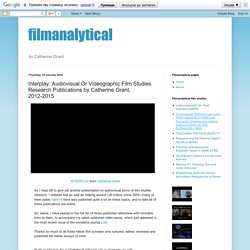
Thanks so much to all those fellow film scholars who nurtured, edited, reviewed and published the below essays of mine. Film and Moving Image Studies Re-Born Digital?’ Some Participant Observations’, Frames, 1, 2012. Moving Pictures beginning with G in AUDIOVISUALCY: Videographic Film and Moving Image Studies. Cinefamily’s Videos on Vimeo. DSLRguide. Tony Zhou on Vimeo. Serious Film. MUST SEE FILMS’s Videos on Vimeo. Interviews & Analysis. Tom Antos’s Videos on Vimeo. Nelson Carvajal on Vimeo. Every Frame a Painting on Vimeo.
David Anderson on Vimeo. The Cinematography of "The Incredibles" - Part 1. Cinematography. תוכן העניינים של הבלוג. Jennine Lanouette on Vimeo. Vashi Nedomansky’s Videos. Visual Storytelling in Filmmaking. February 22, 2015 Film is a brilliant combination of written word, music, sound and pictures, so this week we’re looking at the ways we can tell a story visually, rather than always relying on dialogue to explain things.
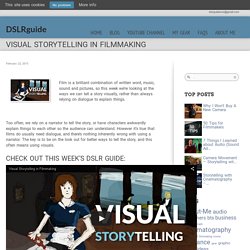
Too often, we rely on a narrator to tell the story, or have characters awkwardly explain things to each other so the audience can understand. However it’s true that films do usually need dialogue, and there’s nothing inherently wrong with using a narrator. The key is to be on the look out for better ways to tell the story, and this often means using visuals. It’s one thing for a character to say exactly how they are feeling, but if can get them to show how they’re feeling then that frees up the dialog for other uses. This Study of Steven Spielberg's Cinematography Can Help You Master the Long Take.
Every Frame a Painting. This is the first of two new videos today.
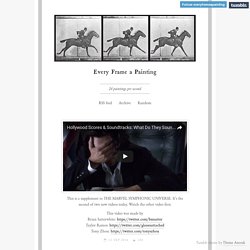
Watch this one first. Off the top of your head, could you sing the theme from Star Wars? How about James Bond? Or Harry Potter? EGIL. Basic Filmmaker. Three-point lighting? Sure, that's cool. But what really makes this method work is the background! USED IN THIS EPISODE:Remote control wail outlet: clamp lights: Cheap Lit Kit with Green Screen: Cinematic Montage Creators on Vimeo. Anatomy of a Scene w/ Director Josh Mond. Camera Movement - Storytelling with Cinematography. Nelson Carvajal’s Videos on Vimeo. Art of the Film’s Videos on Vimeo. Top 10 Best Montages of All Time. Story Wonk. Film Studies Resources.
Indie Cinema Academy on Vimeo. Lighting - Storytelling with Cinematography. Visual Storytelling in Filmmaking. Film Misc on Pinterest. Screenwriting, Film and David Fincher. Kevin B. Lee’s Videos on Vimeo. How to Make A Short Film: Important Tips and Advice. Cinema Squid Movie & TV Screenshots. Directing Motion. Directing Motion Tour Sneak Peek: Breaking Down a Scene from Spielberg's 'Empire of the Sun' As a director or cinematographer, knowing how and when to move the camera is an extremely important skill, and it’s something that takes a lot of practice to get better at. One way to get a better sense of how camera movement can affect a scene is to dissect what the greatest directors and directors of photography have done with their films. A growing archive of stills from the best films ever.
COMPOSITION. The Cinematography of "The Incredibles" - Part 1. Jim Emerson’s Videos.